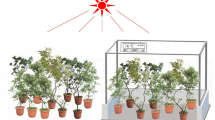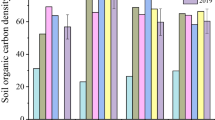Abstract
We conducted a field experiment simulating the warming and drought in a Mediterranean shrubland dominated by Erica multiflora and Globularia alypum with the aim to simulate the next future climate conditions predicted by the IPCC and ecophysiological models. As P is frequently a limiting nutrient in Mediterranean ecosystems, we investigated the drought and warming effects on soil phosphatases activities, soil P contents and availability, litter and leaf P concentration, and the capacity of this community to maintain soil P reserves and retain this nutrient in the ecosystem. Warming treatment increased soil and air temperature (an average of 1°C) and drought treatment decreased soil water content in one of the seasons analysed (28% in autum 2004). Warming increased (68%) the activities of soil acid phosphatases in summer and alkaline phosphatase activity (22%) in spring 2004, and increased P concentrations in E. multiflora. Instead, warming decreased P concentrations in litterfall of this same species, E. multiflora, and soil HCO3-extractable Pi (Olsen-Pi) in some seasons, decreasing total P soil concentration (37%) after 6 years of treatment. The drought treatment did not change soil phosphatase activities, nor available Pi. The effects of climate change on soil P dynamics in Mediterranean areas will thus be strongly dependent on whether the main variable involved in the local change is warming or drought. If warming is the main change without significant changes in water availability, the increases of biological activity can accelerate plant growth, P capture by plants and increase soil-phosphatase activity, altogether decreasing P contents in soil. If drought is the main change, a reduction in P demands by plants is expected, increasing P stocks in soils.



Similar content being viewed by others
References
Amador JA, Glucksman AM, Lyons JB, Gorres JH (1997) Spatial distribution of soil phosphatase activity within a riparian forest. Soil Sci 162:808–825
Asmar F, Eiland F, Nielsen NE (1994) Effect of extracellular-enzyme activities on solubilization rate of soil organic nitrogen. Biol Fertil Soils 17:32–38
Bargagli R, Brown DH, Nelli L (1995) Metal biomonitoring with mosses: procedures for correcting for soil contamination. Environ Pollut 89:169–175
Baum C, Leinweber P, Schlichting A (2003) Effects of chemical conditions in re-wetted peats temporal variation in microbial biomass and acid phosphatase activity within the growing season. Appl Soil Ecol 22:167–174
Carreira JA, Lajtha K, Niell FX (1997) Phosphorus transformations along a soil/vegetation series of fire-prone, dolonmitic, semi-arid shrublands of southern Spain. Biogeochemistry 39:87–120
Chen SK, Edwards CA, Subler S (2003) The influence of two agricultural biostimulants on nitrogen transformations, microbial activity, and plant growth in soil microcosms. Soil Biol Biochem 35:9–19
Bradford KJ, Hsiao TC (1982) Physiological responses to moderate water stress. In: Lange OL, Lange PS, Nobel CB, Osmond CB, Ziegler H (eds) Physiological plant ecology II. Water relations and carbon assimilation, vol 12B. Springer-Verlag, Berlin, Germany, pp 263–324
Deacon HJ (1983) The comparative evolution of Mediterranean-type ecosystems: a southern perspective. In: Kruger FJ, Mitchell FJ, Jarvis JUM (eds) Mediterranean type ecosystems: the role of nutrients. Springer-Verlag, Berlin, pp 3–40
Esteban-Parra MJ, Rodrigo FS, Castro-Diez Y (1998) Spatial and temporal patterns of precipitation in Spain for the period 1880–1992. Int J Clim 18:1557–1574
García C, Roldan A, Hernández T (1997) Changes in microbial activity after abandonment of cultivation in a semiarid Mediterranean environment. J Environ Qual 26:285–291
García C, Hernández T, Roldan A, Martín A (2002) Effect of plant cover decline on chemical microbiological parameters under Mediterranean climate. Soil Biol Biochem 34:635–642
Henkin Z, Seligman NG, Kafkafi U, Noy-Meir I (1998) Effective growing days: a simple predictive model of response of herbaceous plant growth in a Mediterranean ecosystem to variation in rainfall and phosphorus availability. J Ecol 86:137–148
Huxman TE, Synder KA, Tissue D, Leffler AJ, Ogle K, Pockman WT, Sandquist DR, Potts DL (2004) Precipitation pulses and carbon fluxes in semiarid and arid ecosystems. Oecologia 141:254–268
IPCC (2001) Climate change 2001: the scientific basis. In: Hougton JT, Dung Y, Griggs DJ, Noguer M, Van der Linden PJ, Dui X, Maskell K, Johson CA (eds) Contribution of working group I. Third assessement report of intergovermental panel on climate change. Cambridge University Press, Cambridge
Jonasson S, Havström M, Jensen M, Callaghan TV (1993) In situ mineralization of nitrogen and phosphorus of arctic soils after perturbations simulating climate change. Oecologia 93:179–186
Kutiel H, Maheras P, Guika S (1996) Circulation and extreme rainfall conditions in the Eastern Mediterranean during the last century. Int J Clim 16:72–92
Kutiel H, Maheras P (1998) Variations in the temperature regime across the Mediterranean during the last century and their relationship with circulation indices. Theor Appl Climatol 61:39–53
Larcher W (2000) Temperature stress and survival ability of Mediterranean sclerophyllous plants. Plant Biosyst 134:279–295
Li X, Sarah P (2003) Enzyme activities along a climate transect in the Judean desert. Catena 53:349–363
Llorens L, Peñuelas J, Estiarte M (2003) Ecophysiological responses of two Mediterranean shrubs, Erica multiflora and Globularia alypum, to experimentally drier and warmer conditions. Physiol Plant 119:231–243
Llorens L, Peñuelas J, Estiarte M, Bruna P (2004) Contrasting growth changes in two dominant species of a Mediterranean shrubland submitted to experimental drought and warming. Ann Bot 94:843–853
Mayor X, Rodà F (1994) Effects of irrigation and fertilization on stem diameter growth in a Mediterranean holm oak forest. For Ecol Manage 68:119–126
Minerbi S (1987) What effect does climate have on the appearance of the new type of forest damage? Dendronatura 8:9–24
Mooney H (1989) Chaparral physiological ecology-paradigms reexamined. In: Keely SC (ed) The California chaparral. Paradigms reexamined no 34, science series. Natural History Museum of Los Angeles County, Los Angeles
Oliveira G, Correira O, Martins-Louçäo MA, Catarino FM (1994) Phenological and growth patterns of the Mediterranean oak Quercus suber. Trees 9:41–49
Peñuelas J, Filella I, Comas P (2002) Changed plant and animal life cycles from 1952 to 2000 in the Mediterranean region. Glob Change Biol 8:531–544
Peñuelas J, Boada M (2003) A global change-induced biome shift in the Montseny mountains (NE Spain). Glob change Biol 9:131–140
Peñuelas J, Gordon C, Llorens L, Nielssen T, Tietema A, Beier C, Bruna P, Emmett B, Estiarte M, Gorissen A (2004) Nonintrusive field experiments show different plant responses to warming and drought among sites, seasons and species in a north–south European gradient. Ecosystems 7:598–612
Peñuelas J, Filella I, Sabate S, Gracia C (2005) Natural systems: terrestrial ecosystems. In: Llebot JE (ed) Report on climate change in catalonia. Institut d‘Estudis Catalans, Barcelona, pp517–553
Piñol J, Terradas J, Lloret F (1998) Climate warming, wildfire hazard, and wildfire occurrence in coastal eastern Spain. Clim Change 38:347–357
Porter JR (1986) Evaluation of washing procedures for pollution analysis of Ailanthus altissima leaves. Environ Pollut Ser B Chem Phys 12:195–202
Sabaté S, Calvet S, Gràcia CA (1992) Preliminary results of fertilization irrigation experiments in a Quercus ilex L. Ecosystems at prades mountains in tarragona (NE Spain) in relation to leaves and twigs. Vegetatio 99–100:283–287
Sabaté S, Gracia C, Sánchez A (2002) Likely effects of climate change on growth of Quercus ilex, Pinus halepensis, Pinus pinaster, Pinus sylvestris and Fagus sylvatica forests in the Mediterranean region. For Ecol Manage 162:23–37
Sardans J, Rodà F, Peñuelas J (2004) Phosphorus limitation and competitive capacities of Pinus halepensis and Quercus ilex subsp. rotundifolia on different soils. Plant Ecol 174:305–317
Sardans J, Peñuelas P (2004) Increasing drought decreases phosphorus availability in an evergreen Mediterranean forest. Plant Soil 267:367–377
Sardans J, Peñuelas J (2005) Drought decreases soil enzyme actiyity in a Mediterranean holm oak forest. Soil Biol Biochem 37:455–461
Sardans J, Rodà F, Peñuelas J (2005) Effects of water and a nutrient pulse supply on Rosmarinus officinalis growth, nutrient content and flowering in the field. Environ Exp Bot 53:1–11
Schinner F, Öhlinger R, Kandeler E, Margesin R (1996) Methods in soil biology. Springer Lab Manual, Berlin Heidelberg New York, Tokyo, p 426
Sinsabaugh RL, Antibus RK, Linkins AE, McClaugherty CA (1993) Wood decomposition: nitrogen and phosphorus dynamics in relation to extracellular enzyme activity. Ecology 74:1586–1593
Sinsabaugh RL (1994) Enzymic analysis of microbial pattern and process. Biol Fertil Soil 17:69–74
Smith WK, Nobel PS (1977) Influences of seasonal changes in leaf morphology on water-use efficiency for three desert broadleaf shrubs. Ecology 58:2227–2233
Specht RL (1973) Structure and functional response of ecosystems in the Mediterranean climate of Australia. In: Chapman Di Castri F, Mooney HA (eds) Mediterranean-type ecosystems: origen and structure. Chapman and Hall, London, pp 113–120
Specht RL (1979) The sclerophyllous heath vegetation of Australia: the eastern and central states. In: Specht RL (ed) Heathlands and related shrublands. Descriptive Studies. Elsevier, Amsterdam, pp 125–210
Sulkava P, Huhta V (2003) Effects of hard frost and freeze-thaw cycles on descomposer communities and N mineralization in boreal forest soils. Appl Soil Ecol 22:225–239
Tabatabai MA (1982) Soil enzymes. In: Page AL, Millar EM, Keeney DR (eds) Methods of soil analysis. ASA and SSSA, Madison, WI, pp 501–538
Terradas J (2001) Ecología de la vegetación. De la ecofisiología de las plantas a la dinámica de comunidades y paisajes. Omega, Barcelona
Turner BL, Baxter R, Whitton BA (2002) Seasonal phosphatase activity in three characteristic soils of the English uplands polluted by long-term atmospheric nitrogen deposition. Environ Pollut 120:313–317
Viñegla B, García-Ruíz R, Liétor J, Ochoa V, Carreira JA (2006) Soil phosphorus availability and transformation rates in relictic pinsapo fir forest from southern Spain. Biogeochemistry 78:151–172
Watanabe FS, Olsen SR (1965) Test of an ascorbic acid method for determining phosphorus in water and NaHCO3 extracts from soil. Soil Sci Soc Am J 29:677–678
Wick B, Kühne RF, Vlek PLG (1998) Soil microbiological parameters as indicators of soil quality under improved fallow management systems in south–western Nigeria. Plant Soil 202:97–107
Acknowledgements
This research was supported by Spanish Government projects REN2003−04871/GLO, CGL2004-01402/BOS and CGL2006-04025, the Catalan Government project (SGR2005-00312), the European project ALARM (Contract 506675) and a Fundación BBVA 2004 grant. Marc Estiarte acknowledges support from Spanish Ministerio de Educación y Ciencia (Ramon y Cajal contract).
Author information
Authors and Affiliations
Corresponding author
Rights and permissions
About this article
Cite this article
Sardans, J., Peñuelas, J. & Estiarte, M. Warming and drought alter soil phosphatase activity and soil P availability in a Mediterranean shrubland. Plant Soil 289, 227–238 (2006). https://doi.org/10.1007/s11104-006-9131-2
Received:
Accepted:
Published:
Issue Date:
DOI: https://doi.org/10.1007/s11104-006-9131-2




